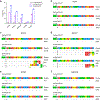An engineered hypercompact CRISPR-Cas12f system with boosted gene-editing activity
- PMID: 37400536
- PMCID: PMC10625714
- DOI: 10.1038/s41589-023-01380-9
An engineered hypercompact CRISPR-Cas12f system with boosted gene-editing activity
Erratum in
-
Author Correction: An engineered hypercompact CRISPR-Cas12f system with boosted gene-editing activity.Nat Chem Biol. 2024 Jan;20(1):129. doi: 10.1038/s41589-023-01508-x. Nat Chem Biol. 2024. PMID: 38040979 No abstract available.
Abstract
Compact CRISPR-Cas systems offer versatile treatment options for genetic disorders, but their application is often limited by modest gene-editing activity. Here we present enAsCas12f, an engineered RNA-guided DNA endonuclease up to 11.3-fold more potent than its parent protein, AsCas12f, and one-third of the size of SpCas9. enAsCas12f shows higher DNA cleavage activity than wild-type AsCas12f in vitro and functions broadly in human cells, delivering up to 69.8% insertions and deletions at user-specified genomic loci. Minimal off-target editing is observed with enAsCas12f, suggesting that boosted on-target activity does not impair genome-wide specificity. We determine the cryo-electron microscopy (cryo-EM) structure of the AsCas12f-sgRNA-DNA complex at a resolution of 2.9 Å, which reveals dimerization-mediated substrate recognition and cleavage. Structure-guided single guide RNA (sgRNA) engineering leads to sgRNA-v2, which is 33% shorter than the full-length sgRNA, but with on par activity. Together, the engineered hypercompact AsCas12f system enables robust and faithful gene editing in mammalian cells.
© 2023. The Author(s), under exclusive licence to Springer Nature America, Inc.
Conflict of interest statement
Competing interests
T.W., S.Z., and W.T. are inventors on a U.S. provisional patent application on enAsCas12f. T.W. is a shareholder of AccuraDX Inc. The other authors declare no competing interests.
Figures





Similar articles
-
An AsCas12f-based compact genome-editing tool derived by deep mutational scanning and structural analysis.Cell. 2023 Oct 26;186(22):4920-4935.e23. doi: 10.1016/j.cell.2023.08.031. Epub 2023 Sep 29. Cell. 2023. PMID: 37776859
-
Efficient genome editing in rice with miniature Cas12f variants.aBIOTECH. 2024 May 28;5(2):184-188. doi: 10.1007/s42994-024-00168-2. eCollection 2024 Jun. aBIOTECH. 2024. PMID: 38974870 Free PMC article.
-
Chimeric CRISPR-CasX enzymes and guide RNAs for improved genome editing activity.Mol Cell. 2022 Mar 17;82(6):1199-1209.e6. doi: 10.1016/j.molcel.2022.02.002. Epub 2022 Feb 25. Mol Cell. 2022. PMID: 35219382 Free PMC article.
-
Computational Tools and Resources for CRISPR/Cas Genome Editing.Genomics Proteomics Bioinformatics. 2023 Feb;21(1):108-126. doi: 10.1016/j.gpb.2022.02.006. Epub 2022 Mar 24. Genomics Proteomics Bioinformatics. 2023. PMID: 35341983 Free PMC article. Review.
-
Prime Editing in Mammals: The Next Generation of Precision Genome Editing.CRISPR J. 2022 Dec;5(6):746-768. doi: 10.1089/crispr.2022.0084. CRISPR J. 2022. PMID: 36512351 Review.
Cited by
-
Robust miniature Cas-based transcriptional modulation by engineering Un1Cas12f1 and tethering Sso7d.Mol Ther. 2024 Apr 3;32(4):910-919. doi: 10.1016/j.ymthe.2024.02.013. Epub 2024 Feb 12. Mol Ther. 2024. PMID: 38351611 Free PMC article.
-
Engineered circular guide RNAs enhance miniature CRISPR/Cas12f-based gene activation and adenine base editing.Nat Commun. 2025 Mar 28;16(1):3016. doi: 10.1038/s41467-025-58367-4. Nat Commun. 2025. PMID: 40148327 Free PMC article.
-
Gene disruption via a transient hypercompact CRISPR-AsCas12f1 system in Kluyveromyces marxianus.Biotechnol Lett. 2025 Jul 31;47(4):84. doi: 10.1007/s10529-025-03626-z. Biotechnol Lett. 2025. PMID: 40742466
-
Precision in Action: The Role of Clustered Regularly Interspaced Short Palindromic Repeats/Cas in Gene Therapies.Vaccines (Basel). 2024 Jun 7;12(6):636. doi: 10.3390/vaccines12060636. Vaccines (Basel). 2024. PMID: 38932365 Free PMC article. Review.
-
Structural basis of RNA-guided transcription by a dCas12f-σE-RNAP complex.bioRxiv [Preprint]. 2025 Jun 11:2025.06.10.658880. doi: 10.1101/2025.06.10.658880. bioRxiv. 2025. PMID: 40661421 Free PMC article. Preprint.
References
-
- Mojica FJM, Díez-Villaseñor C.s., García-Martínez J & Soria E Intervening sequences of regularly spaced prokaryotic repeats derive from foreign genetic elements. J. Mol. Evol. 60, 174–182 (2005). - PubMed
-
- Barrangou R et al. CRISPR provides acquired resistance against viruses in prokaryotes. Science 315, 1709–1712 (2007). - PubMed
-
- Anzalone AV, Koblan LW & Liu DR Genome editing with CRISPR–Cas nucleases, base editors, transposases and prime editors. Nat. Biotechnol. 38, 824–844 (2020). - PubMed
MeSH terms
Substances
Grants and funding
LinkOut - more resources
Full Text Sources
Other Literature Sources
Molecular Biology Databases
Research Materials

